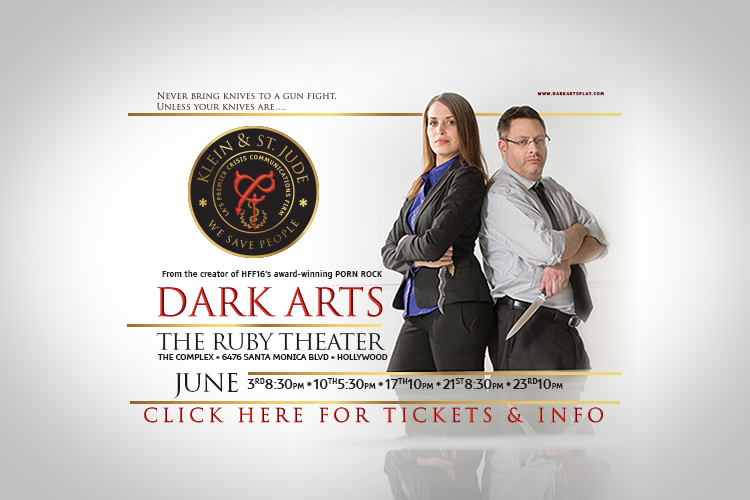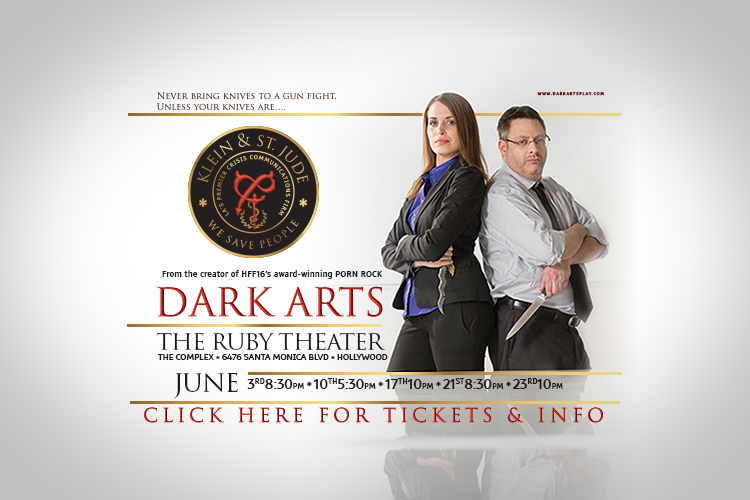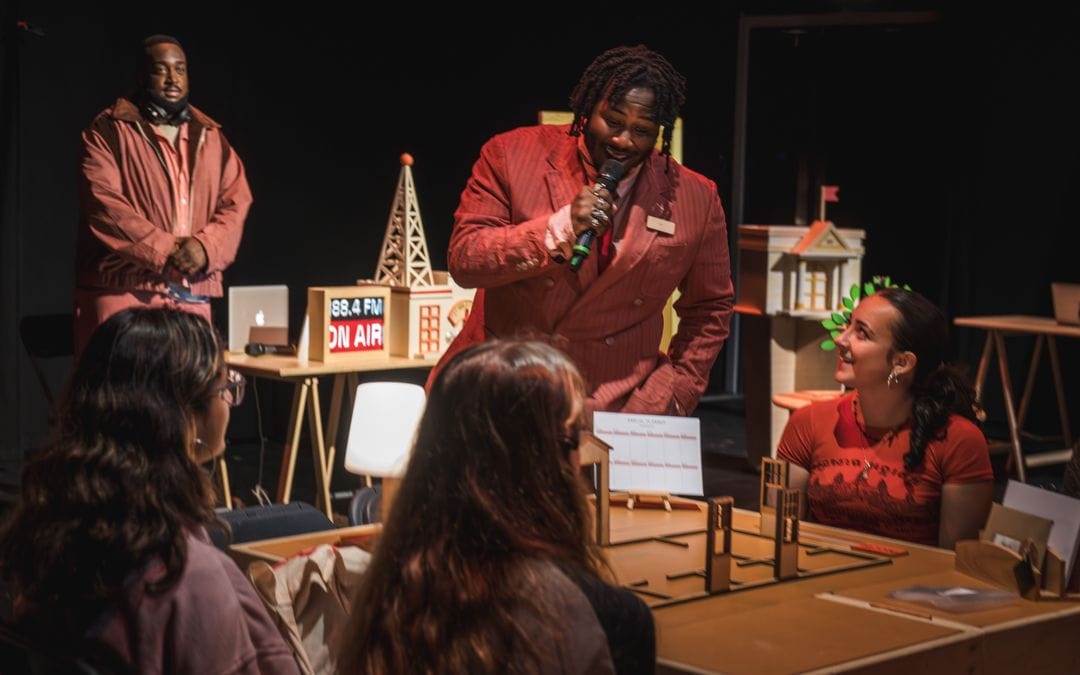
Dark Arts writer-star Lawrence Meyers is a big fan of immersive theatre, and it shows in a lot of what he does. In particular Meyers is a fan of The Tension Experience, and that love has influenced a lot of Dark Arts, a theatrical experiment that ties together an immersively staged prelude and finale with an ensemble theatre show.
The ensemble piece pretty much stands on its own, telling the story of the partners at Klein & St. Jude, a crisis communications firm locked in a seemingly never-ending battle with the forces of government corruption. Meyers plays Andrew St. Jude, a fast-talking, profane fireball who’d be right at home in an Armando Iannucci (Veep, The Thick of It) show. His partner — which we quickly learn is in more ways than one — is Lyndsey Klein, played with loving grace and patience by Stephanie Hyden, a veteran of The Tension Experience.
In fact there’s a lot of Tension vets in the cast — with Damien Gerard playing the heavy and Terrence Leclere giving a delightfully broad comic turn as an incompetent EPA inspector.
The show is at its best when it’s Meyers and Hyden, and while I might not agree with the vision of the world that Meyers puts forth through the mouthpiece of St. Jude, he does a damn good job of doing it. Not quite faring as well is the fact that this is a unit set play — which means that it’s all taking place in the same room, as many plays do — in a world that screams for some space to roam.
The inborn tension of the piece — no pun intended — is between the verisimilitude demanded of a unit set and Meyers’ instincts to build an expansive world.
He addresses the later, somewhat, in the prelude to Dark Arts, which is available as a separate ticketed experience.
In that pop-up, individual audience members are given the chance to have their crises managed by Klein & St. Jude. Here Meyers draws upon his experience as someone who actually works in crisis communications. It’s also an opportunity to get some of the story of the show ahead of time. I did the prelude before I saw the show, wondering if it was going to add an extra dimension to the proceedings.
Unfortunately, on the level of narrative, it merely established a primary storyline of the play. A kind of “pre-peat” of the narrative to come. Inasmuch as it did this, it detracted from the back and forth with the characters, which was the most interesting part. Although I also admit it might have been more interesting to meet those characters after seeing them on-stage, rather than encountering them in an alternate reality layer first. Both Meyers and Hyden are very comfortable in their own skin as performers, and the time spent watching them on stage made me appreciate the time I had spent with them off stage as Klein & St. Jude.
Yet the existence of the prelude raises some odd questions: like why Klein has to answer the door while they had an assistant during the prelude. Sure, there’s a real world answer: that actor was just the check-in person for the immersive prologue. It’s not a very satisfying answer.
There are also a couple of different approaches you can take with the prologue. You could, if you wanted to, bring in some of your real world issues. It’s clear Meyers anticipates this, as the liability waver states in plain language that what’s about to take place is not licensed therapy.
From time to time it is fun to bring some real world problems to imaginary people, but having been down that rabbit hole a few dozen times I decided instead to indulge in just about the worst version of myself imaginable. A real through the looking glass media shark embroiled in a death spiral with TMZ. That we started off the session talking about their problems and not mine was kind of a bummer.
But we got there, and the banter back and forth laced with allusions to their personal situation felt like what the piece really wanted to be.
In short: there’s something here, but it’s not quite there yet. I think Meyer’s instincts that an ensemble piece can be snapped into the frame of a larger world is correct. He’s also got access to actors who are quite skilled at the immersive form and a taste for worldbuilding.
Is that something a show that involves three separate ticketed events in order to get the full experience, which is how the whole of Dark Arts is constructed? I honestly don’t think so.
This is, however, what Fringe is for: taking big bets and seeing where the chips fall. You have to hand it to Meyers for not just playing it safe and making a House of Cards knockoff on a unit set. Points for ambition and experimentation, and some hope that Meyers keeps playing in these kinds of sandboxes.
Dark Arts is playing as part of the Hollywood Fringe Festival. Four dates for the mainstage show, June 10–23. Tickets: $15. For more info on the immersive prelude/finale visit Dark Arts Play.
Join the fastest growing immersive arts & entertainment community on the planet: EVERYTHING IMMERSIVE




















Discussion